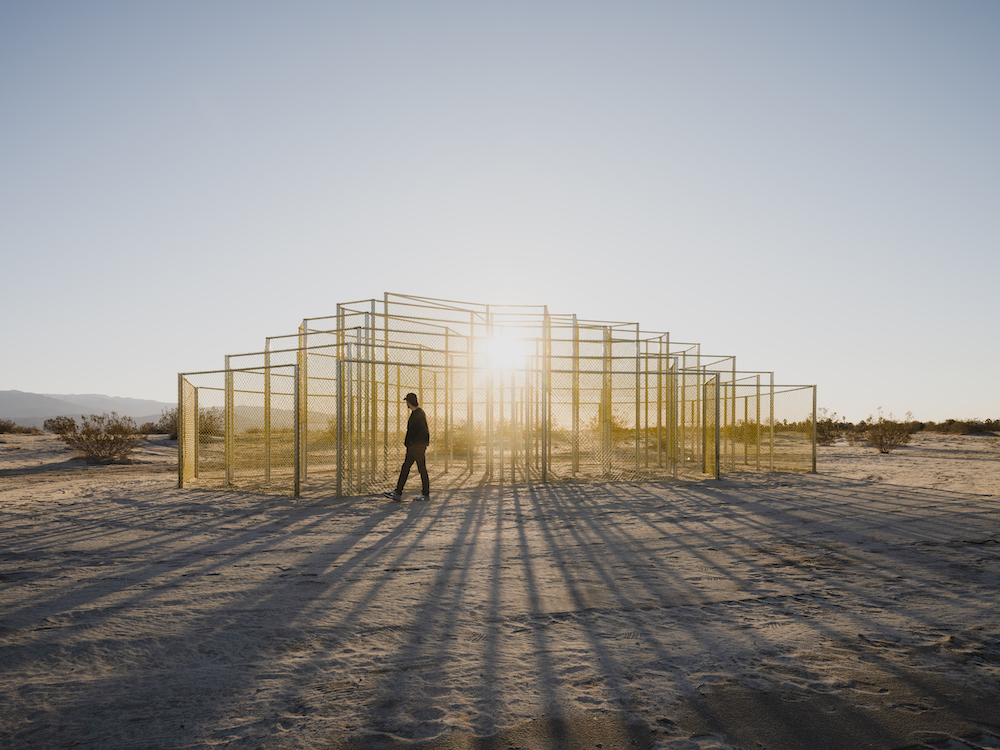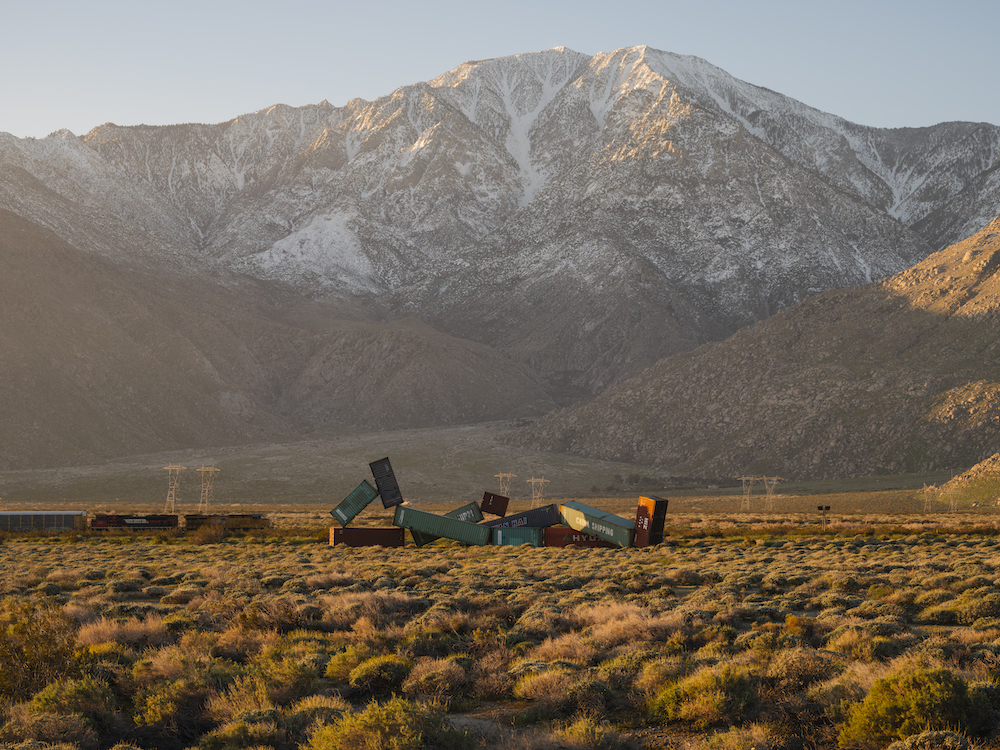In another sign of an unusually wet winter in Southern California, the desert and foothills of Coachella Valley are painted a lush green, the tops of the San Jacinto Mountains dusted with a few inches of stark white snow. It is against this startlingly serene backdrop that the 2023 iteration of Desert X, a young and ambitious biennial, blossoms across the sun-kissed Fantasyland of Palm Springs.
Departing bright and early for the press preview day on March 3, I made the two-hour drive east from Los Angeles to the Desert X hub at the Ace Hotel & Swim Club to enjoy refreshments under the sun and hear opening remarks from this year’s organizers.
There’s a saying attributed to the Kwakwaka’wakw nation that artistic director Neville Wakefield used to frame the exhibition: “A place is a story happening many times.” In recognition of the force humans exert upon the natural world, the 12 international artists selected for this year’s presentation by Wakefield and co-curator Diana Campbell serve as documentarians of the stories and mythologies as historic and encompassing the desert holds.
To the curators’ credit, this year’s artworks move away from replicating the legacies of land artists like Robert Smithson and Walter De Maria who once dominated the American West. Instead, it foregrounds women and artists of color whose work recontextualizes our connections to the desert and amplifies issues of social and environmental justice in greater depth, breathing new life into the arid landscape.
One such work comes from Tshabalala Self in the form of Pioneer, my first stop of the day. In a provocative interpretation of a commemorative equestrian statue, a disembodied female torso with legs triumphantly splayed across the back of a kneeling horse displaces the classic image of a macho colonialist on horseback. The monumental bronze sculpture was built in homage to Black and Indigenous foremothers whose bodies and labor allowed contemporary America to develop. Its placement, nestled away in a shady grove at the end of a sandy, half-mile hike through Desert Hot Springs, echoes how the histories of women of color were shunned away from city centers—and thus, our collective consciousness. But here, the sculpture’s assertive presence celebrates the rightful place in the American landscape of all the marginalized groups it represents.
Next, I made my way a few miles north to Mexican artist Mario García Torres’ Searching for the Sky (While Maintaining Equilibrium). Another short hike from the parking area later, the desert gave way to a herd of mechanical bulls made of skyward-facing metallic sheets reminiscent of solar panels writhing out-of-sync on electric pedestals. I climbed to the top of a nearby dune and watched aerially over Torres’ clever commentary on cowboy culture, searching for patterns in the bulls’ movements but eventually settling on the futility of humans attempting to harness any semblance of control over these wild animals or the unforgiving environment we found them in.
In a cinematic experience activated by driving along Gene Autry Trail, I encountered an equally poignant sequence of billboards featuring photographs by Tyre Nichols, the 29-year-old Black man fatally beaten by Memphis police in January. Each photograph in the series titled “Originals” stands out within the desert empire of roadside signs, advertising unassuming and hopeful images of landscapes, sunsets and architectural spaces, yet tinged with reminders of the roadside violence that claimed Nichols’ life too early. Arranged at the last minute, the work is a nod to the curators’ commitment to centering social issues and a continuation of the biennial’s tradition of utilizing billboards as sites of artistic expression blended into the existing desert infrastructure.

Desert X 2023 installation view, Tyre Nichols, Originals, GoFundMe Tyre Nichols Memorial Fund, photo by Lance Gerber.
Gerald Clarke’s Immersion is the installation most deeply rooted in the indigenous history of the region. A university professor and local Cahuilla tribal leader, Clarke has constructed a monumental maze-like gameboard atop a woven straw apparatus he describes as “like Native Trivial Pursuit.” The interactive piece comes with a set of custom playing cards with trivia questions based on indigenous intellectual tradition, a design that, Clarke conceded, would give the average American visitor a hard time and compel them to cheat—just as they have cheated Native peoples out of just about everything. As he predicted, I found it nearly impossible to navigate the walk-on boardgame in the manner Clarke intended and had to stop myself from giving in to my inclination to simply google the answers. But I was rewarded with new ways of viewing the landscape and brought home with me a reminder of erased local histories, as well as a desire to do better in educating myself.
After a quick detour for a poolside Spanish lunch, I embarked eastbound to Cathedral City for my next stop at Sunnylands Center, whose botanical gardens host Amar a Dios en Tierra de Indios, Es Oficio Maternal by Mexico City–based artist Paloma Conteras Lomas. The installation centers on a silver 1991 Chevy Caprice that has seemingly broken down among the cacti. A vibrant tangle of plush textile forms—including stuffed sombreros, phallic forms bearing stuffed guns, clumps of flowers and furry clawed limbs—erupt from the vehicle’s windows, windshield, roof and trunk, spilling onto the manicured lawn in absurdist fashion. I took a moment to sit in the car’s back seat, where
Lomas included an audio-visual component, and was overcome with the odd sensation that I was a hapless passenger being stewarded toward my impending doom by a playful cast of alien characters. In contrast to a softness that invites children to hug its billowing appendages, the work addresses heavy topics of class violence and colonial guilt with a tongue-in-cheek lightness.
Located a five-minute drive east of Sunnylands came one of the most powerful installations in the biennial—British-Bangladeshi artist Rana Begum’s otherworldly No.1225 Chainlink. Responding to the ubiquity of the chain-link-fence pattern seen across Coachella Valley, Begum reclaims its dual associations of protection and exclusion: Her labyrinthine installation combines harsh industrial materials with the meditative, ritualistic experience visitors get from meandering through a concentric pavilion she has built out of chain-link fences painted bright yellow. What at first feels like a claustrophobic spiral proved to be an expansive rather than reductive structure, with the center giving way to a clearing that allows people to flow through the enclosure just as easily as wind, water, sand and sunlight filter through the repetitive metal slots. Flanked by rolling hills and miles of shrubbery dotting the desertscape, No.1225 Chainlink is unnervingly imposing yet gracefully sensuous. Begum smartly diffuses the material’s divisive connotations through rhyming geometric architecture.

Desert X 2023 installation view, Rana Begum, No. 1225 Chainlink, photo by Lance Gerber, courtesy the artist and Desert X.
Throughout, Desert X 2023 centers the significance of water to desertscapes, and three key installations create instruments reflecting the physicality of water cycles and climate change in drastically different ways. Salt, in turn, features heavily as a counterpart to water and a marker of its dearth. New York–based artist Torkwase Dyson’s Liquid A Place—the southernmost installation located in Palm Desert—is a large-scale abstract sculpture taking an utterly unique and meditative form of a gigantic, matte-black arch with a womb-like cutout. It invites viewers (as our bodies are predominantly water) to be a part of the history of water in this space as we travel through and over the piece via an implanted staircase. At the northwest corner of Desert Hot Springs, a towering telegraph pole submerged in coarse salt emits sonorous “prayers” from trumpet-shaped loudspeakers flowering from its top. Created by the London- and Delhi-based duo Himali Singh Soin and David Soin Tappeser, collectively known as Hylozoic/Desires, the multimedia Namak Nazar broadcasts curious echoes and tales into the vast barren landscape, a humorous nod to the proliferation of conspiracy theories borne out of the desert.
Finally, The Smallest Sea with the Largest Heart by Lauren Bon and Metabolic Studio is a mesh steel sculpture in the form a life-sized blue whale heart that hangs suspended in a pool of water from the Salton Sea. But rather than serve as portent of climate disaster, the sculpture metabolizes the shallow saline pond into clean energy and water, reminding us that the desert we stand in was once a sea and fueling the potential for new life over the run of the exhibition.
Just off by the I-10 intersects with a cross-continental freight rail line lies LA-based artist Matt Johnson’s epic Sleeping Figure. The work comprises 12 shipping containers propped precipitously in a humanoid form lounging laconically at the base of a snow-capped mountain range, replete with a painted sleepy smile. Sited within eyeshot of the cars roaring down the freeway toward the Port of Los Angeles, the colossal sculpture speaks aptly to the fragility and inescapability of the global economy and supply chain. Just as I was about to veer onto the I-10 West ramp, a freight train towing countless dozens of shipping containers identical to the ones making up Johnson’s sculpture thundered through the background of Sleeping Figure and into the receding horizon. I paused to watch before following suit in my car, feeling utterly transformed by my day in the desert and ready to chase the setting sun back to Los Angeles.


